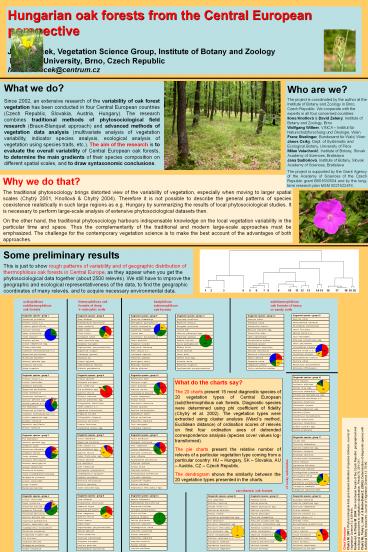Snmek 1 - PowerPoint PPT Presentation
1 / 1
Title:
Snmek 1
Description:
Dianthus carthusianorum s.l. Hieracium pilosella. Poa nemoralis. Galium pumilum s.l. ... Dianthus carthusianorum s.l. Phleum phleoides. Luzula campestris agg. ... – PowerPoint PPT presentation
Number of Views:111
Avg rating:3.0/5.0
Title: Snmek 1
1
Hungarian oak forests from the Central European
perspective
Jan Rolecek, Vegetation Science Group, Institute
of Botany and Zoology Masaryk University, Brno,
Czech Republic honza.rolecek_at_centrum.cz
Who are we? The project is coordinated by the
author at the Institute of Botany and Zoology in
Brno, Czech Republic. We cooperate with the
experts in all four concerned countriesIlona
Knollová David Zelený, Institute of Botany and
Zoology, Brno Wolfgang Willner, VINCA Institut
für Naturschutzforschung und Ökologie, Wien Franz
Starlinger, Bundesamt für Wald, Wien János Csiky,
Dept. of Systematic and Ecological Botany,
University of Pécs Milan Valachovic, Institute of
Botany, Slovak Academy of Sciences,
Bratislava Jana Sadlonová, Institute of Botany,
Slovak Academy of Sciences, Bratislava The
project is supported by the Grant Agency of the
Academy of Sciences of the Czech Republic grant
B601630504 and by the long-term research plan MSM
0021622416.
What we do? Since 2002, an extensive research of
the variability of oak forest vegetation has been
conducted in four Central European countries
(Czech Republic, Slovakia, Austria, Hungary). The
research combines traditional methods of
phytosociological field research (Braun-Blanquet
approach) and advanced methods of vegetation data
analysis (multivariate analysis of vegetation
variability, indicator species analysis,
ecological analysis of vegetation using species
traits, etc.). The aim of the research is to
evaluate the overall variability of Central
European oak forests, to determine the main
gradients of their species composition on
different spatial scales, and to draw
syntaxonomic conclusions.
Who are we? The project is coordinated by the
author at the Institute of Botany and Zoology in
Brno, Czech Republic. We cooperate with the
experts in all four concerned countries Ilona
Knollová David Zelený, Institute of Botany and
Zoology, Brno Wolfgang Willner, VINCA Institut
für Naturschutzforschung und Ökologie, Wien Franz
Starlinger, Bundesamt für Wald, Wien János Csiky,
Dept. of Systematic and Ecological Botany,
University of Pécs Milan Valachovic, Institute of
Botany, Slovak Academy of Sciences,
Bratislava Jana Sadlonová, Institute of Botany,
Slovak Academy of Sciences, Bratislava The
project is supported by the Grant Agency of the
Academy of Sciences of the Czech Republic grant
B601630504 and by the long-term research plan MSM
0021622416.
Why we do that? The traditional
phytosociology brings distorted view of the
variability of vegetation, especially when moving
to larger spatial scales (Chytrý 2001, Knollová
Chytrý 2004). Therefore it is not possible to
describe the general patterns of species
coexistence realistically in such large regions
as e.g. Hungary by summarizing the results of
local phytosociological studies. It is necessary
to perform large-scale analysis of extensive
phytosociological datasets then. On the other
hand, the traditional phytosociology harbours
indispensable knowledge on the local vegetation
variability in the particular time and space.
Thus the complementarity of the traditional and
modern large-scale approaches must be emphasized.
The challenge for the contemporary vegetation
science is to make the best account of the
advantages of both approaches.
Some preliminary results This is just to show
rough patterns of variability and of geographic
distribution of thermophilous oak forests in
Central Europe, as they appear when you get the
phytosociological data together (about 2500
relevés). We still have to improve the geographic
and ecological representativeness of the data, to
find the geographic coordinates of many relevés,
and to acquire necessary environmental data.
1 2 3
4 5 6 7 8 9
10 11 12 13 14 15 16 17
18 19 20
acidophilous subthermophilous oak forests
thermophilous oak forests of deep - eutrophic
soils
basiphilous subxerophilous oak forests
subthermophilous oak forests of heavy or sandy
soils
SK
CZ
CZ
HU
AU
AU
AU
CZ
SK
HU
AU
CZ
HU
SK
HU
CZ
AU
SK
What do the charts say? The 20 charts present 15
most diagnostic species of 20 vegetation types of
Central European (sub)thermophilous oak forests.
Diagnostic species were determined using phi
coefficient of fidelity (Chytrý et al. 2002). The
vegetation types were extracted using cluster
analysis (Wards method, Euclidean distance) of
ordination scores of relevés on first four
ordination axes of detrended correspondence
analysis (species cover values log-transformed).
The pie charts present the relative number of
relevés of a particular vegetation type coming
from a particular country HU Hungary, SK
Slovakia, AU Austria, CZ Czech Republic. The
dendrogram shows the similarity between the 20
vegetation types presented in the charts.
CZ
AU
CZ
AU
SK
HU
SK
AU
SK
HU
HU
SK
AU
CZ
CZ
HU
CZ
HU
HU
AU
SK
SK
SK
CZ
AU
Cited literature Chytrý M. 2001
Phytosociological data give biased estimates of
species richness. Journal of Vegetation Science
12 439-444. Knollová I. Chytrý M. 2004
Oak-hornbeam forests of the Czech Republic
geographical and ecological approaches to
vegetation classification. Preslia 76
291-311. Chytrý M., Tichý L., Holt J.
Botta-Dukát Z. (2002) Determination of
diagnostic species with statistical fidelity
measures. Journal of Vegetation Science 13
79-90.
of rocky substrates
CZ
AU
SK
xerothermic oak forests
HU
SK
CZ
HU
AU
AU
SK
AU
CZ
CZ
HU
HU
SK
SK
AU
SK































